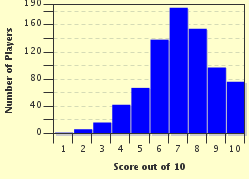Quiz Answer Key and Fun Facts
1. What is solder made of?
2. How hot should a soldering iron be in order to solder leaded solder?
3. It is good to use a lot of solder when placing components on boards?
4. What tools are needed to solder circuit boards?
5. What can be used to clean circuit boards when you are finished soldering?
6. What is a "cold" solder joint?
7. Should solder be reheated on a circuit board (keeping the same solder, not resoldering with new metal)?
8. Is it safe to eat or drink while soldering?
9. When soldering, a technician needs to take care not to damage the board by wearing a wrist strap to protect the board from ESD. What is ESD?
10. What are common names for some primary discrete components used on circuit boards?
Source: Author
Mobunny
This quiz was reviewed by FunTrivia editor
crisw before going online.
Any errors found in FunTrivia content are routinely corrected through our feedback system.

